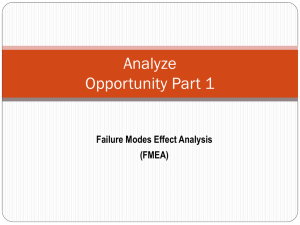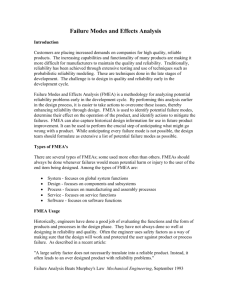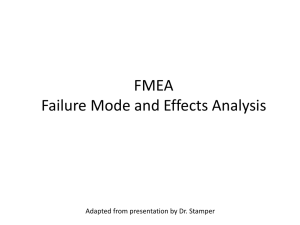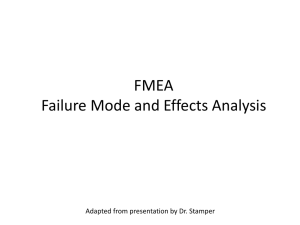Test Planning and Failure Modes and Effects Analysis (FMEA)
advertisement
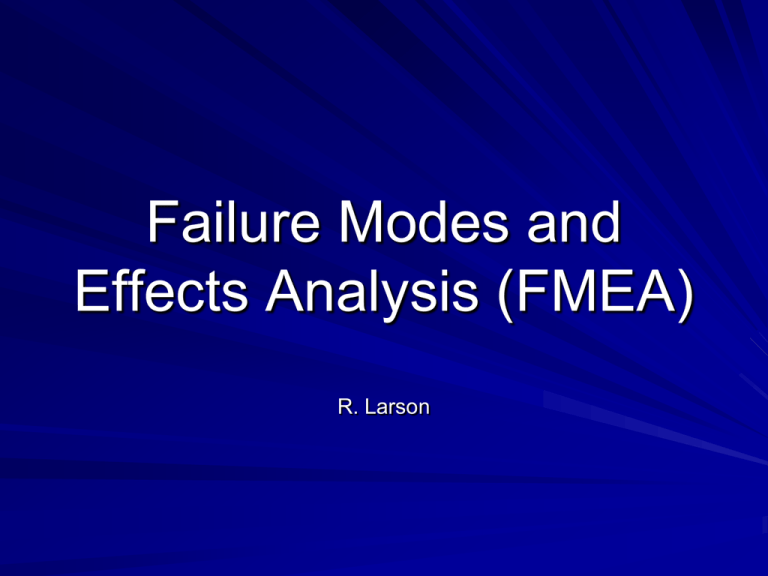
Failure Modes and Effects Analysis (FMEA) R. Larson Failure Mode and Effects Analysis (FMEA) An analysis technique used to identify potential design or process problems Method examines effects of lower level failures. Identifies where actions or compensating provisions are needed to – reduce the likelihood of the problem occurring, and – mitigate the risk, if problem does occur. Failure Mode and Effects Analysis (FMEA) Application in Industry – FMEA Project teams made up of experts from engineering, manufacturing, etc assigned to review the concept, design, process or system – The FMEA team determines the effect of each failure and identifies single failure points that are critical. – Team may also rank each failure according to failure effect probability and criticality, to assign importance. Failure Mode Effects and Criticality Analysis (FMECA) Another similar technique, extension of FMEA The FMECA is the result of two steps: – Failure Mode and Effect Analysis (FMEA) – Criticality Analysis (CA) to evaluate the frequency of occurrence of the problems identified. Varieties of FMEAs. Conceptual FMEAs Functional FMEAs Design FMEAs Process FMEAs (e.g. Manufacturing process) – Alternatives: Review combination of functions and hardware. Review just hardware Review just function Review of system down to a piece-part level is common if critical functions or hardware are involved. Design failure modes effects analysis (DFMEA) Identifies potential failures of a design element before occurrence. Establishes the cause of potential failures Anticipates effects and severity of effect resulting from the failure Determines how often and when failures might occur Manufacturing Process FMEA (Process FMEA, or PFMEA) Recognize and evaluate the potential failure of a process and its effect Identify actions which could eliminate or reduce the occurrence of failure, or improve likelihood of detection Document the process Track changes to process-incorporated to avoid potential failures Why is FMEA / FMECA Important? FMEA provides a basis for identifying root failure causes and developing effective corrective actions The FMEA identifies reliability/safety of critical components It facilitates investigation of design alternatives at all design stages Provides a foundation for other maintainability, safety, testability, and logistics analyses A Pro-active engineering quality method Also… Helps you to identify and counter weak points Works in the early conception phase of all kinds of products (hardware, software) and processes Structured approach = easy to use even for a non-specialist Widely used in industrial, medical, business areas. FMEA / FMECA Background and History An offshoot of 1949 Military Procedure MIL-P-1629, entitled “Procedures for Performing a Failure Mode, Effects and Criticality Analysis” Used as a reliability evaluation technique to determine the effect of system and equipment failures. Failures were classified according to their impact on mission success and personnel/equipment safety. Formally developed and applied by NASA in the 1960’s to improve and verify reliability of space program hardware. The procedures called out in MIL-STD-1629A are the most widely accepted methods throughout the military and commercial industry. Similar SAE J1739 is a prevalent FMEA standard in the automotive industry. Mil-Std-1629A Related FMEA Definitions Compensating Provision: Actions available or that can be taken to negate or reduce the effect of a failure on a system. Criticality: a measure of the frequency of occurrence of an effect. May be based on qualitative judgement or may be based on failure rate data. Detection Method: The method by which a failure can be discovered by the system operator under normal system operation or by a maintenance crew carrying out a specific diagnostic action. End Effect: The consequence a failure mode has upon the operation, function or status at the highest indenture level. Failure Cause: The physical or chemical processes, design defects, quality defects, part misapplication or other processes which are the basic reason for failure or which can initiate the physical process by which deterioration proceeds to failure. Failure Effect: The consequence of a failure mode has upon the operation, function or status of a system or equipment. FMEA Definitions (cont.) Failure Mode: The way in which a failure is observed, describes the way the failure occurs, and its impact on equipment operation. Indenture Levels: The levels which identify or describe the relative complexity of an assembly or function. Local Effect: The consequence a failure mode has on the operation, function or status of the specific item being analyzed. Mission Phase Operational Mode: The statement of the mission phase and mode of operation of the system or equipment in which the failure occurs. Next Higher Level Effect: The consequence a failure mode has on the operation, functions, or status of the items in the next higher indenture level above the specific item begin analyzed. Severity: Considers the worst possible consequence of a failure classified by the degree of injury, property damage, system damage and mission loss that could occur (ref: Mil-Std-1629A FMECA severities). Single Point Failure: The failure of an item which can result in the failure of the system and is not compensated for by redundancy or alternative operational procedure. An Inductive (Bottom-to-top) FMEA approach… • What are the effects of box failures on the system? What are the effects of board failures on the box? • What are the effects of part failures on the board? A Deductive Top-to-Bottom approach also can be used… Block Diagrams of two approaches: Bottom-Up vs Top-Down 2008 Formula SAE Car Suspension Structural Failure Primary Failure: Adhesive Joint in L. Rear Toe Rod: Note bare aluminum insert in lower left of image, where carbon tube pulled off clean. This failure resulted in bending/crushing failure of a-arms, and the subsequent impact caused severe racking of the aluminum rear structure. Secondary Effects of Failure Implementation into Design Process Methodology The FMEA Analysis Process: 1) Define the system -Construct block diagrams, DBS, function diagrams 2) Identify and list the potential failures -Research. Comparisons, brainstorm, models 3) List possible causes or mechanisms -Tolerance stack-up, overstressing, etc. 4) List the potential effects of the failure -noise, odor, erratic performance, inoperative 5) Rate the likelihood of occurrence (O) The FMEA Process: (cont.) 6) Estimate potential severity (S) 7) Assess detection (D) 8) Calculate Risk Priority Number (RPN) -nonlinear in risk, review carefully to determine critical items in your system 9) Feed results back into design process -Identify better means of failure detection? -Develop compensating provisions? Etc… 10) Implement corrective action or Redesign. Repeat analysis to determine effectiveness of the actions 1) Define the system List each subassembly and component number along with basic functions Basic functions should match design intent May list environmental and operational parameters (temp, vibe, pressure) to clarify design intent 2) Identify and list the potential failures Try to understand the physics of potential problems Use Free-body Diagrams, Storyboards, Process-flow diagrams, etc. Do some research. Compare with existing or similar products. Build scale models. Analyze via computer or otherwise. (Notice FEA is not the only method!!) 3) List possible causes or mechanisms ------Example Failure Modes Acoustic noise Fracture Seizure Binding Intermittent Operation Staining Buckling Leaks Stall Burning Material Yield Stripping Corrosion Misalignment Surge Cracking Open Circuit Thermal Expansion Creep Oxidation Tensile/Compressive material Failure Deflection/Deformation Radiation Damage Unstable Unbalanced Delamination Resonance UV Deterioration Electrical short Ringing Vibrations Erosion Sagging Wear Fatigue Scoring Wobble 4) List the potential effects of the failure Noise Odor Fire Erratic performance Critical Structural Failure Non-critical Structural Failure Excessive vibration Fit problems Durability issues Other Quality or functional problems… 5) Rate the likelihood of occurrence (O) Occurrence is a numerical subjective estimate of the LIKELIHOOD that the cause, if it occurs, will produce the failure mode and its particular effect. Occurrence (O) 6) Estimate potential severity (S) Severity is a numerical, subjective estimate of severity Can also be construed as how severe the customer or end user will perceive the failure effect Not always the same! Severity (S) 7) Assess detection (D) Detection is a numerical, subjective estimate of the effectiveness of the controls used to prevent or detect the cause or failure mode Detection should occur before the failure affects the finished product (before product reaches the customer.) For this parameter, the assumption is that the cause has occurred. Detection (D) 8) Calculate the Risk Priority Number (RPN) Provides a qualitative numerical estimate of design risk. Nonlinear in risk, numbers are relative for a given evaluation process Review carefully to determine critical items in your system Be careful If comparing work of different teams, different products Risk Priority Number (RPN) is defined as the product of the three independently assessed factors: RPN = (S) * (O) * (D) where Severity = (S), Occurrence = (O), and Detection = (D). 9) Feed results back into design process Corrective actions developed on a priority basis Assign Responsibility for Implementation of corrective action Scheduling of corrective action items is key to product development and improvement Implementation into Design Process Methodology 10) Implement corrective action or Redesign. Repeat RPN analysis to determine effectiveness of the actions FMEA Template for Design and Development Extend to FMECA CONCEPT FMEA (CFMEA) The Concept FMEA is used to analyze concepts in the early stages before hardware is defined (most often at system and subsystem) It focuses on potential failure modes associated with the proposed functions of a concept proposal This type of FMEA includes the interaction of multiple systems and interaction between the elements of a system at the concept stages. references http://www.fmeainfocentre.com/examples/36VbatFMEA. pdf http://www.fmeainfocentre.com/examples/FMEAworkshe et.pdf http://www.fmeainfocentre.com/examples/xfmea_dfmea. pdf “Product Design”, Kevin Otto and Kristin Wood, Prentice Hall, 2001








